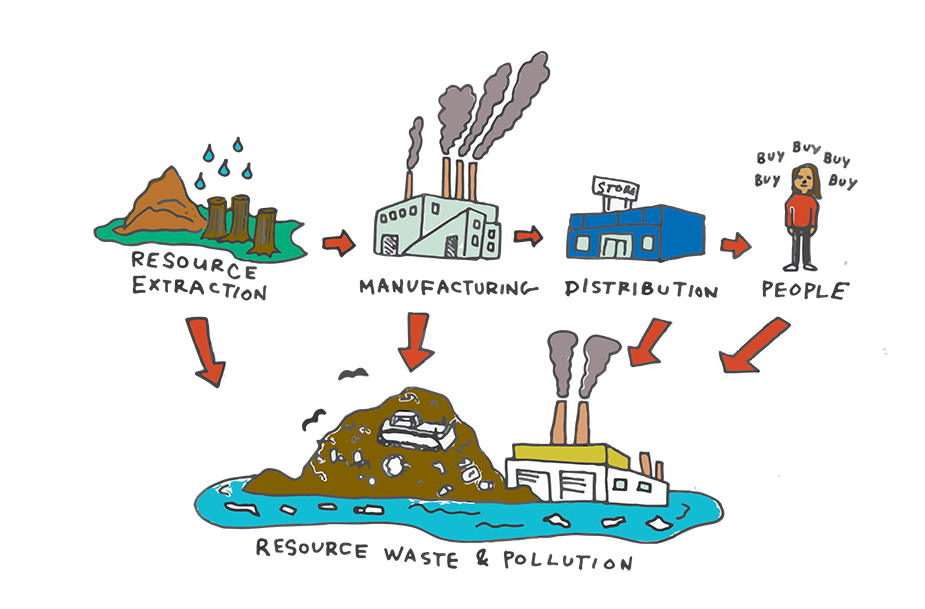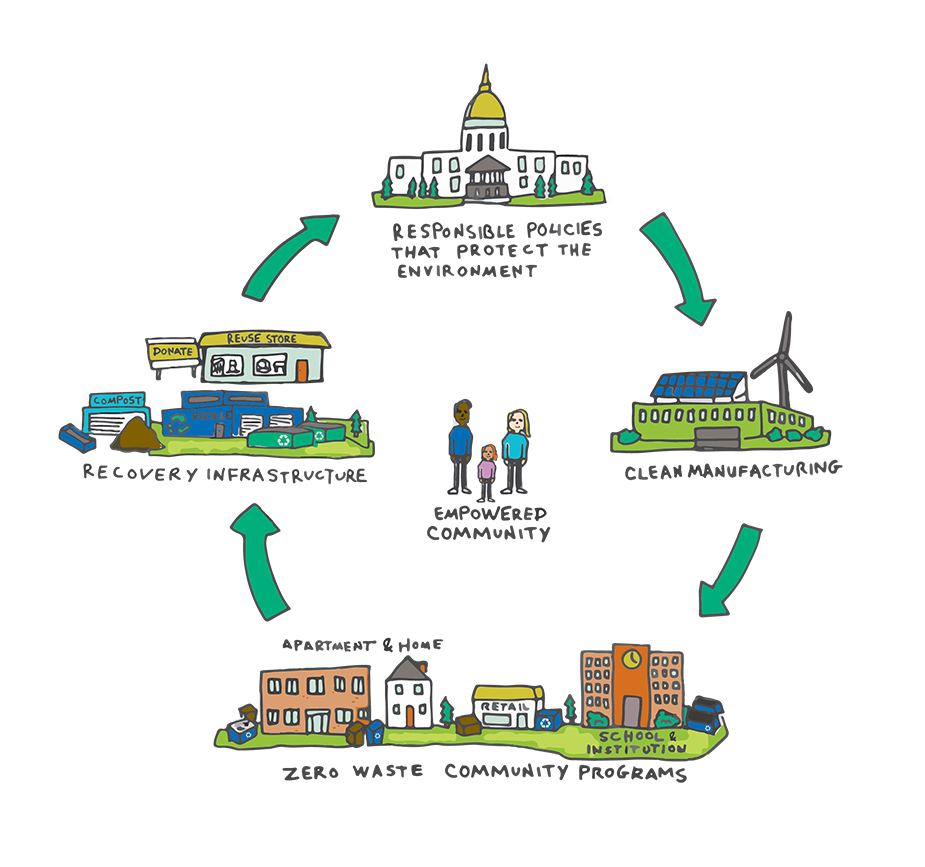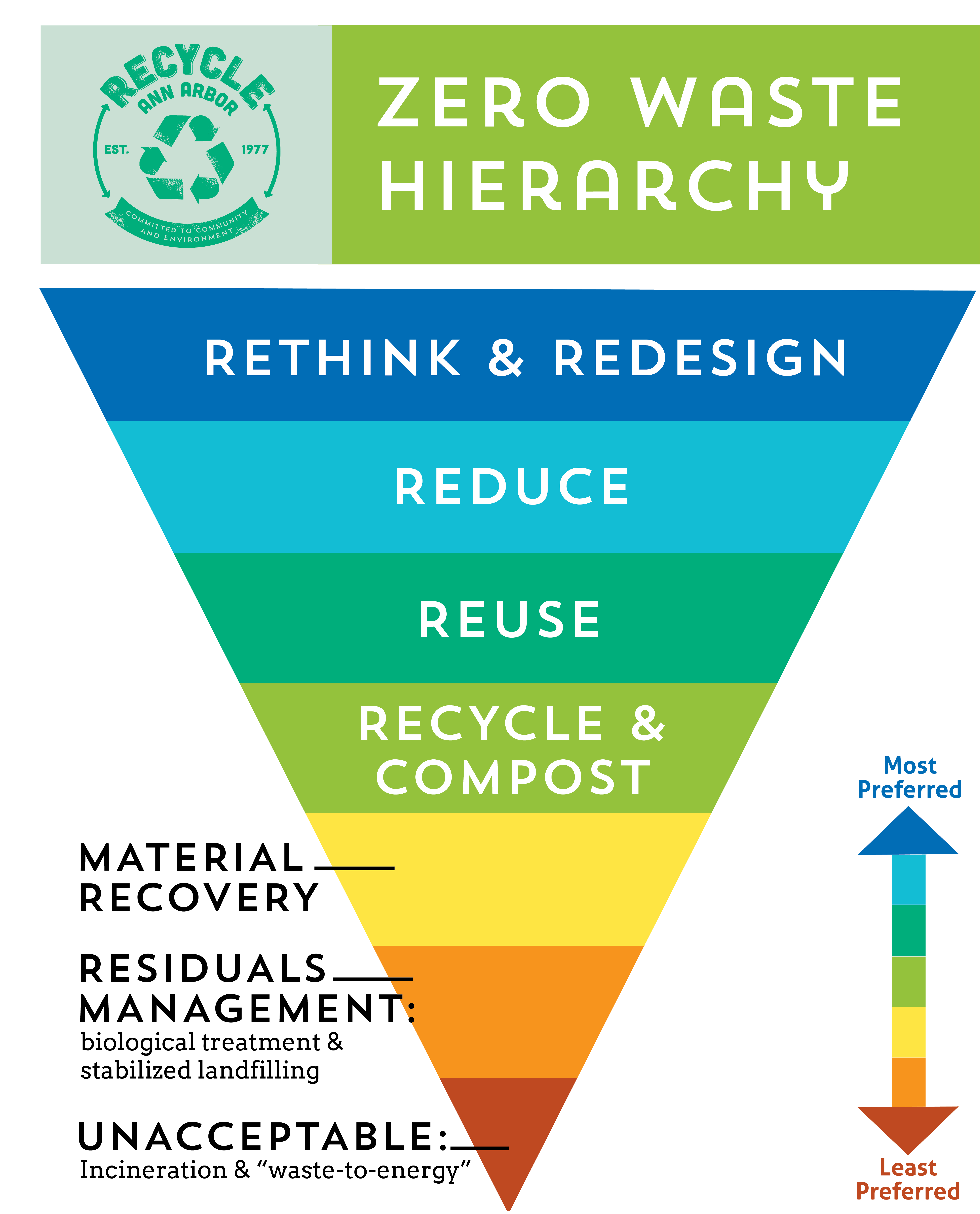Zero Waste Community
What is Zero Waste?
“Zero Waste” is becoming a more popular term - but what does it mean? We want to be clear about how we view zero waste and how it can benefit our community and the planet.
Zero waste is not just reducing the amount of materials that we as consumers throw away in our garbage cans. It also isn’t recycling and composting 100% of what we use. While those actions are very important, zero waste is so much more than that! Zero waste aims to address the whole system of the way we use resources.
For every can of garbage at our curb, there are 87 cans worth of materials that come from the extraction industries—such as timber, agricultural, mining and petroleum—that manufacture natural resources into finished products (World Resources Institute). So even if we recycle and compost all of the waste we generate at the individual level, that still doesn’t address all of the waste created before us. Let’s imagine that the waste from production was not so high - zero waste still calls for reducing resource use wherever possible and to always put resources to their highest and best use so we can conserve natural resources and protect the natural world.
A zero waste system takes into account the whole life cycle of products. It is a complete revision of our current system for extracting, using, and disposing of natural resources. It includes sustainable and clean manufacturing processes that don’t compromise Earth’s life-sustaining systems. It requires producers that design products with their end of life in mind. It includes balanced resource recovery infrastructure. It is rooted in supportive policies and citizen participation. It is guided by nature’s cyclical and regenerative systems where there is no such thing as waste.
On the global level, zero waste calls for redesigning the entire system of how we extract, design, produce, distribute, use, and manage resources so we can conserve natural resources and minimize our impact on the environment.
On the community level, zero waste requires local policies that protect our natural resources and support sustainable material use, collaborative community programs that facilitate products being put to their highest and best use, and strong local economies.
On the individual level, zero waste means making intentional purchases of necessary items that we know are produced responsibly, can be reused, and can be easily recycled or composted locally at the end of their “useful” life.
We support the Zero Waste International Alliance definition of zero waste that has been peer-reviewed and internationally accepted:
“Zero waste is a goal that is ethical, economical, efficient and visionary, to guide people in changing their lifestyles and practices to emulate sustainable natural cycles, where all discarded materials are designed to become resources for others to use. Zero waste means designing and managing products and processes to systematically avoid and eliminate the volume and toxicity of waste and materials, conserve and recover all resources, and not burn or bury them. Implementing zero waste will eliminate all discharges to land, water or air that are a threat to planetary, human, animal or plant health”
Why is Zero Waste so important?
Our current system for resource use is unsustainable. According to the Global Footprint Network, over 80 percent of the world’s population lives in a country that is in “ecological deficit”, which means they use more resources than the ecosystem is able to regenerate. Humanity has been in global ecological overshoot since the 1970s. They estimate that we currently use the equivalent of 1.7 Earths for the resources we use and the waste we create, meaning it takes the Earth one year and six months to replenish what we consume in one year.
Our current system is a linear production-consumption-disposal model that looks like this:

A Zero Waste system is cyclical (the way resources flow in nature) and it looks like this:

The following are NOT “Zero Waste”:
- 100% recycling and composting. Products that can be recycled and composted are great, but zero waste takes into account the whole life cycle of a product and always prioritizes waste prevention, product design, and reuse before recycling and composting. Just because something can be recycled doesn’t mean it is the best choice. Recyclability often perpetuates the use of single-use items because people think if an item can be recycled then there is no problem using as much of it as they want. For example, you can recycle paper bags but they still require resources and energy to create and to recycle so using a reusable bag is preferred.
- Absolutely zero items are discarded. We follow the ZWIA definition of zero waste, which considers that to mean 90% of materials are diverted from landfills and incinerators.
- “Zero Waste to Landfill”. A lot of entities have adopted a “Zero Waste to Landfill” goal. This suggests that incineration and Waste-To-Energy are acceptable and puts the focus on products end-of-life. When we bury or burn resources we have given up the opportunity to put those resources to their highest and best use. This exacerbates the current cultural belief that when we’re done with items we can just throw them “away” and then we need to extract more raw materials from the planet.
- Waste Management. Our current system’s focus is on how to manage our waste. A Zero Waste system views everything as a resource and shifts the focus to resource management, which aims to take into account a product’s entire life cycle.
Tips for a Zero Waste Lifestyle.
The first step towards a Zero Waste Lifestyle is to learn how to reduce your waste stream impact. The second step is to opt to reuse instead of buying new whenever possible. Last, plan ahead so that materials used are recyclable or compostable locally.
- Buy in bulk
- Use reusable produce bags
- Use reusable bags instead of plastic sandwich bags
- If you do use plastic bags, wash and reuse
- Use reusable Bags for grocers and other shopping too
- Don’t take a bag for small purchases
- Reduce packaging
- Prepare meals to reduce leftovers
- Reduce your holiday food waste
- Bring reusable leftover containers
- Use reusable towels for cleaning instead of paper towels
- Use travel mugs and reusable mugs instead of paper cups
- Avoid single serving pre-packaged foods
- Compost all food waste
- Donate old items
- Avoid one-time use decorations
- Avoid ordering take-out, dine in or at home. And, if you do order take make sure to ask ahead if they use styrofoam or not. Styrofoam is not even recyclable
- Shop at local reuse centers and thrift stores
- Recycle everything you can
- In addition to printing only when needed, print double-sided paper and save printed paper for taking notes
- Parents: Use cloth diapers and cloth wipes
- Have a cold? Use handkerchiefs instead of kleenex
- You can recycle construction and demolition waste for your home projects
- Repair and repurpose appliances, furniture and electronics before replacing them
- Buy your electronics refurbished
- Only replace clothing and electronics when necessary
- Use a reusable water bottle
- Use reusable cutlery
